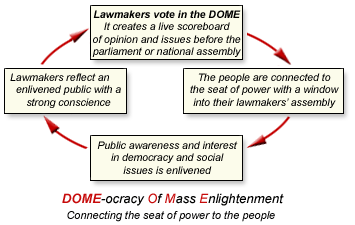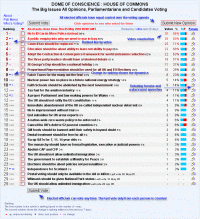
History
Media Reports
Hansard Extracts
People of Influence
Letters to Lawmakers
Contact
Quotes
"I think this is a great idea and I hope all Members of all
Parliaments will join it," said leading political analyst, Malcolm Mackerras,
School of Politics, University of NSW, Australian Defence
Force Academy. (year 2002)
"It is an additional window on the workings of parliament, it is a
constructive use of modern technology for information and for insight
into our democracy," Greg Hunt MP, Member for Flinders, Parliament
of Australia. (Hansard 24 September 2002)
"MPs participation in the DOME will help enliven
the interest of all people in the political process and
we as Members of Parliament have this challenge to break
cynicism and apathy. It's our challenge no one else's," said
Robert
Oakeshott MP, Member for Port Macquarie, Parliament of New South
Wales. (27 June 2002)
"There are many important issues that do not
feature on the political agenda. The DOME will
allow all MPs to have a role in setting the agenda," said the late Anthony
McGrane MP, Member for Dubbo, Parliament of New South Wales.
(year 2002)
More quotes . .
A community service project by
BigPulse Opinion Markets
Lawmakers Voting Chambers
A country is activated as soon as one lawmaker requests voting access —
Add another country

It's a free floating lawmakers' Opinion Market. It produces a live scoreboard of issues before each parliament or national assembly.
In this voting chamber all lawmakers have equal control over the voting agenda and all can speak at the same time. Voting is transparent. Everyone can see exactly how each lawmaker votes and who does not vote.
Yet it shows much more -- an integrated representative voice of all participating lawmakers, understood at a glance -- and this is the first thing people see as they enter the forum. With a single click people can also see the integrated voice of each assembly, each party and the separate voices of the upper and lower houses.
The DOME creates a continuous connection between the people and the seat of power. Public awareness and interest in social issues will be enlivened.
How the DOME Works
The DOME uses the free speech polling technology invented by BigPulse.com. All lawmakers can access their assembly's DOME of Conscience in this website and float a new opinion at any time by clicking the "Submit New Opinion" button. Opinions are expressed as concise single line statements called "placards". All opinion placards compete continuously for votes from lawmakers and are ranked live for all to see. Repeat voting is encouraged and never causes vote stacking as the system counts the last vote only for each forum member.Click any opinion to see the names of all lawmakers who voted for it. Click the names to see all opinions voted for by lawmakers the last time they voted. Click the "Who's Voting" link to see a list of all lawmakers who are members of the parliament, congress or legislature and the date of their last vote.
New opinion placards are published live but the author's identity is suppressed and no vote is record in the process of floating a new opinion placard. This means lawmakers can also float ideas they do not intend to vote for. All votes are counted live.
On the far right of each opinion placard there is a dedicated debating forum where lawmakers can post comments and speeches.
History
27 June 2002 - The DOME of Conscience project was launched. It was supported by a mention in the Parliament of New South Wales by independent Robert Oakeshott MP.24 September 2002 - The dome was launched in the Federal Parliament of Australia by government member Greg Hunt MP.
Voting was anonymous in the first version of the DOME. By request from lawmakers transparent voting was introduced several months later.
18 March 2003 - Harry Quick MP, Deputy Opposition Whip, invited all parliamentarians to visit the DOME and vote on the Iraq issue. By this time 10 parliamentarians in the Parliament of NSW and 10 in the Federal Parliament had signed in and voted in the DOME. This included independents and parliamentarians from the five largest political parties. Queensland Senator Andrew Bartlett, leader of the Australian Democrats, became the first leader of a major political party to vote in the DOME.
2 September 2004 - Former magistrate Brian Deegan, father of Bali bombing victim Josh, and candidate for the seat of Mayo become the first candidate to commit to voting regularly in the DOME of Conscience, if elected. He said, "The DOME of Conscience represents exactly what I am standing for, transparency and honesty in government."
October 2004 - The DOME really came to life for the first time in the leadup to the October 04 General Election in Australia when 145 federal candidates voted in it.
6 October 2004 - Independent Peter King, Member for Wentworth, a Rhodes Scholar and a former NSW State President of the Liberal Party voted in the DOME and said, "A transparent parliament means a stronger democracy and this is good for the economy, environment, security, social justice and the health of everyone".
May 2005 - In the leadup to the May 05 General Election in the UK 55 candidates and MPs voted at www.ukdome.com.
20 October 2005 - A new DOME was opened for all federal and state parliamentarians in Australia. Over 800 parliamentarians were pre-registered to vote. An email letter was sent to all parliamentarians inviting them to vote.
01 December 2005 - 18 Australian parliamentarians voted in a single issue DOME Opinion Market called Van Ngyuen's Appeal for Clemency. 94 per cent voted for Let Van Nguyen Live. 18 is the largest lawmaker participation in the DOME to date. Half the parliamentarians who voted are in the federal parliament. For the first time most of those voting are from the major parties.
09 November 2007 - Candidates' DOME of Conscience – Election 2007, Parliament of Australia, launched.
09 August 2010 - Candidates' DOME of Conscience – Election 2010, Parliament of Australia, launched.
Media Reports
On 3 July, 2002 Vivian Schenker interviewed Robert Oakeshott MP on the ABC Radio National Breakfast Show.The DOME of Conscience featured in the Australian on 15 October 2002. The report stated "The DOME of Conscience — a groundbreaking internet site that lets opinions compete against each other like shares in a stock market".


